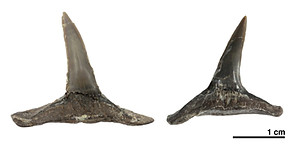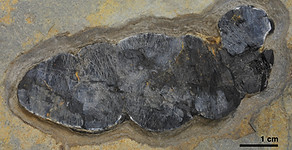

Yasuhisa NAKAJIMA, Ph.D
Vertebrate Paleontologist
Evolutionary Biologist
RESEARCH INTERESTS
Reconstruction of Mesozoic ecosystems
What on the Earth lived from 250-66 million years ago?
Why did they get extinct?
Physiology of extinct vertebrates
How did huge dinosaurs and marine reptiles grew up?
How did they eat, breed, and die?
The Bones
How did we acquired the bones?
What can bones tell us about the life of an animal?
MY LATEST RESEARCHES

DUROPHAGY is a mode of feeding habit, in which an animal crush hard-shelled prey. Here we reported fossil jawbones from the Lower Triassic (ca. 248 million years old) strata in Miyagi Prefecture, northeastern Japan. One of the fossil bones is associated with numerous bulbous teeth, similar to omphalosaurids known from USA and Spitzbergen. Such a dental morphology indicates a durophagous diet, preying on shelled molluscs or crustaceans. The marine ecosystems were on the way to the recovery from the mass extinction event. Still, now it is suggested that the marine predators likely diversified and geographically radiated very rapidly.
(photo: the teeth associated with a jawbone found from the Osawa Formation)

DUROPHAGY is a mode of feeding habit, in which an animal crush hard-shelled prey. Here we reported fossil jawbones from the Lower Triassic (ca. 248 million years old) strata in Miyagi Prefecture, northeastern Japan. One of the fossil bones is associated with numerous bulbous teeth, similar to omphalosaurids known from USA and Spitzbergen. Such a dental morphology indicates a durophagous diet, preying on shelled molluscs or crustaceans. The marine ecosystems were on the way to the recovery from the mass extinction event. Still, now it is suggested that the marine predators likely diversified and geographically radiated very rapidly.
(photo: the teeth associated with a jawbone found from the Osawa Formation)

FRESHWATER SHARKS AND RAYS are present, not only in modern ecosystems but also in Mesozoic rivers and ponds. Here we preliminarily report the occurrence of sharks and ray tooth fossils from the Late Cretaceous (~80 million years ago) fluvial deposit Tamagawa Formation in NorthEastern Japan. Fossil collection from a bonebed includes lamniform sharks and sawfish-like rays, dinosaurs, crocodilians, and freshwater turtles. This finding illuminates an ancient invasion of cartilaginous fishes into the riverine environment.
(photo: A tiny rostral spine of an extinct sawfish visualized using Micro-focus CT scan)

ICHTHYOSAURS are fish-shaped marine reptiles lived in the Mesozoic ocean. The vertebral shape varies according to what kind of fish they looked like, namely eel-like or tuna-like. According to our new research, bone microstructure varies depending on vertebral shape, and it seems to have changed from heterogenous to homogenous structure during the evolution. Unlike other animals, the whole density of bone did not decrease through their history under the sea.
(photo: Various microstructures of ichchyosaur bones seen under the microscope)

PLESIOSAURS are among the iconic marine reptiles that ruled the ocean during the Mesozoic era. They possessed a short trunk, four wing-shaped flippers, and very often, the long neck. We reported the first undoubted plesiosaur skeleton from the Triassic found in Germany. This finding confirms that this group appeared during Triassic and then survived a mass extinction event that happened at Triassic-Jurassic boundary 201 million years ago.
(photo: The holotype of the oldest plesiosaur Rhaeticosaurus mertensi)

SOFTSHELL TURTLES are globally distributed freshwater turtles in the present world. New fossils and its microscopic structure reveals that this kind originated in Asia around 120 million years ago. Dispersal of turtles to the New World took place in the Cretaceous greenhouse condition, and then they determined a part of present-day freshwater turtle fauna. (photo: Plywood-like bone microstructure of softshell turtles)

SPHENODUS, the ancient sharks were found from the 86 million yeas old rock from Hokkaido, Japan, as fossil teeth. The T-shaped tooth of this shark is very fragile and hardly preserved as complete. Compiled records including our findings revealed that this shark preferred the cold water, but dissappeared due to the global warming that happened 50 million yeas ago. (photo: Sphenodus teeth from the Cretaceous of Hokkaido)

COPROLITES are fossilized feces. We found the oldest (ca. 247 million years old) coprolites from Japan. It has been believed that at that time the marine ecosystem was on the way of recovery from the biggest mass extinction, which happened five million years before. Using coprolites, we reconstructed the food web, which was unexpectedly complex. (photo: A vertebrate coprolite from the Triassic in Miyagi)

DUROPHAGY is a mode of feeding habit, in which an animal crush hard-shelled prey. Here we reported fossil jawbones from the Lower Triassic (ca. 248 million years old) strata in Miyagi Prefecture, northeastern Japan. One of the fossil bones is associated with numerous bulbous teeth, similar to omphalosaurids known from USA and Spitzbergen. Such a dental morphology indicates a durophagous diet, preying on shelled molluscs or crustaceans. The marine ecosystems were on the way to the recovery from the mass extinction event. Still, now it is suggested that the marine predators likely diversified and geographically radiated very rapidly.
(photo: the teeth associated with a jawbone found from the Osawa Formation)